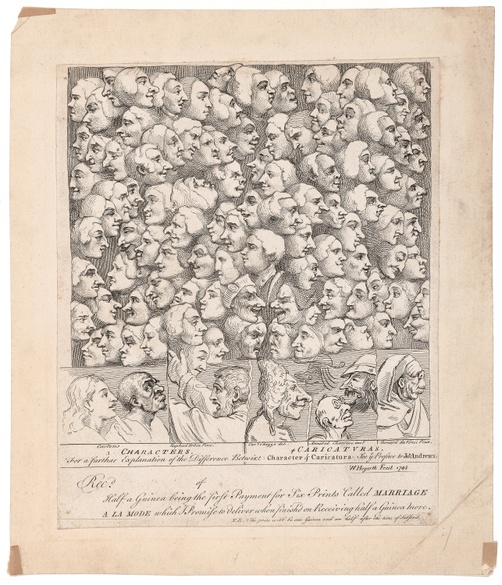Adding item...
Collection Artwork

Artist
William Hogarth (London, England, 1697 – 1764, London, England)
Title
Characters and Caricaturas
Creation date
1743
Materials
etching; first state
Dimensions
image size: 8 1/8 x 8 1/4 in.
paper size: 10 x 8 1/4 in.
board size: 12 1/4 x 10 5/8 in.
paper size: 10 x 8 1/4 in.
paper size: 10 x 8 1/4 in.
board size: 12 1/4 x 10 5/8 in.
paper size: 10 x 8 1/4 in.
Credit Line
Bequest of Edwin de Turck Bechtel
Place of Creation
England, Europe
Accession Number
1957.47
Object Type
Marks
Inscribed in pencil, lower right, on board: i/ [?]
Inscribed in pencil, verso, upper center: 8 ¾ x 10 ½ [upside-down]
Stamped in black ink, verso, lower left: 14300
Stamped in black ink, lower center, verso: [collector’s stamp]
Inscribed in pencil, verso, lower right: First State.
Inscribed in pencil, verso, upper center: 8 ¾ x 10 ½ [upside-down]
Stamped in black ink, verso, lower left: 14300
Stamped in black ink, lower center, verso: [collector’s stamp]
Inscribed in pencil, verso, lower right: First State.
Object Label
France’s Louis XIV continued the rage for elaborate long hair. When his “natural glory” thinned, he resorted to wigs. The fashion spread beyond France, but not without controversy. A Massachusetts pastor’s “Essay Against Periwigs” condemned wigs as deceitful, unmanly, and against God. But like Renaissance beards, wigs signified masculinity and authority, connotations alive today in England’s judicial and political systems. In the 18th century, wigs became objects of satire. Hogarth mocks the pretentiousness of wig styles available to pompous aristocrats and men of power. His typology parodies the classical treatise on architectural orders by Roman author Vitruvius.
From the exhibition: Hair: Untangling a Social History (January 24 – June 6, 2004)
Ongoing Research
Research on our collection is ongoing. If you have resources you’d like to share, please contact Associate Curator Rebecca McNamara.
Learn more

Hair: Untangling a Social History
Exhibition